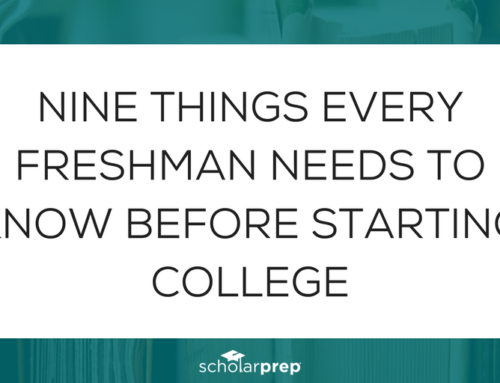This is a guest blog post written by our friend Angela, the founder and owner of P-A Financial Services (PAFS). She works to increase financial literacy among children, teens, and young adults. While working in the financial services industry, Angela discovered that many teens and young adults were just like her when she was in high school and college; a young person without the skills and knowledge to manage her money. Today, she is sharing her knowledge with children, teens, and young adults who are getting ready to enter their adults lives. We encourage you to learn more about P-A Financial Services (PAFS).
My personal philosophy for my kid’s education has been that they do not have to go to college, but I want them to be able to go to college if that is their desire. I fought long and hard to obtain my undergraduate and graduate degrees later in life, and I did not want my kids to go through the same experience. While my philosophy translated to academically and emotionally preparing them, it didn’t translate as well when preparing for the financial cost.
Early in our marriage funds were tight and setting aside money for our young children’s college was difficult. My husband was good with numbers and finances, but I knew little about budgeting and even less about investing. Also, when our kids were one and two years of age, it seems like college is years and years away. We felt like there will always be time to start a college fund. We did get around to saving some money, but college costs have doubled in the past 20 years according to College Board.
According to Travis Mitchell in his U.S. News article, Chart: See 20 Years of Tuition Growth at National Universities, they have more than doubled. Mitchell states the average increase in costs for private National Universities is shocking at 179%. He goes on to share that increases in out-of-state and in-state tuition and fees for public universities are worse at 226% and 296%, respectively.
Not only did we not prepare or anticipate such staggering increases in college costs, but we were also slow to prepare our kids to assist with everyday costs while attending college. College is a time when kids are in flux. They are old enough to be independent but still need financial assistance.
Here is a list of some of the expenses that kids still incur while at college:
- Personal Grooming: Haircuts, coloring, waxing, etc.
- Personal Hygiene Products: Toothpaste, shampoo, conditioner, hair gels, shaving cream, razors, skin care products, and the list goes on.
- Campus Activities: Colleges plan activities that cost extra.
- Transportation: Whether a student rides a bike, has a vehicle, or takes public transportation, there are costs involved. Bike break down, vehicles need fuel, and public transportation has fees.
- Snacks: Many colleges offer meal plans and flex dollars, but we have found it’s not enough to feed hungry college boys.
College kids do learn to go without some of these things, but many are not prepared to do so. Or, they may expect mom and dad to make college life feel like home life. In our experience, it’s good for them to learn to dial down on spending and expectations; however, preparing them and ourselves would have made the experience less stressful. How do parents prepare themselves and their kids financially for college?
They prepare by starting early, starting small, and building onto the foundation.
First, create a workable a budget.
It’s never too late to start! Never. If budgeting seems overwhelming or feels like a foreign language, get educated. There are many resources and people out there who want to help. Also, do not stick to just one resource. Learn from as many resources as you can to learn different ways of managing finances.
Second, begin saving money.
There are some great programs out there that allow for saving for even tight budgets. One example is Acorns, an investment company that rounds up purchases to the nearest whole dollar and deposits the difference into an investment account. The way it works for participants is if a purchase is $23.46, for example, the purchase is rounded up to $24.00. The difference of 54¢ is deposited into their account. Our oldest son has been using this Acorns for over a year now. The program lets your pick the risk level you are comfortable with, but not which funds are invested. He had $5.00 in his account in the first week. Multiplying that over 52 weeks, he could have $260 in a year depending on the number of purchases he makes. There are other investment strategies like Acorns, so ask friends and search around to discover other opportunities.
Third, if your children are young, start teaching them about budgeting their money with easy concepts they can understand.
Continue expanding their knowledge as they grow up. Don’t just focus on savings and budgeting, but teach them terminologies such as credit, debit, debts, assets, liabilities, etc. Teach them skills like writing a check and how to count back change. When they are ready, teach them how to reconcile an account. Include your kids in practicing to budget and manage money. Now, before you stop reading, hear me out. You don’t have to share your actual finances with them. You can, though, give them a small weekly allowance with the agreement that they have to budget that allowance. Sure, they will not have expenses, but you can incorporate the ideas of savings, giving, and financial discipline at an early age. They can write down purchases they make into an account register. Even if your kids are older, you can begin this process. It may be a bit painful at first, but if you make it fun and they start seeing their savings increase, most will get into the process.
Fourth, increase savings and investment strategies as your budget allows.
There are a variety of college mutual fund programs available. Once you can set aside as little as $25 a month, it’s time to talk to a financial advisor about your options. Working toward setting aside at least 10% of your monthly is a good goal. Whether your choose 10% of gross or net income is debated among many, but the more you can set aside the better.
Fifth, start talking to your kids early about prepping for college.
As I mentioned in the first paragraph, I stressed to my kids that they don’t have to go to college, but they need to study hard, so it’s an available option if they want to go. Along with studying hard, they need to plan financially and know what steps to take to get into the college of their choice. ScholarPrep suggests starting kids their 9th-grade year; however, I think starting them in 8th grade isn’t too early. My daughter is in 11th, and while we started a lot of planning with her in 8th grade, I just purchased the ScholarPrep Organizer because her goals are a bit bigger than both our son’s college goals.
There is a lot we parents can do to help our kid’s prepare for college. Whether your kids are tiny tots or already in college, it’s not too late to start prepping!












